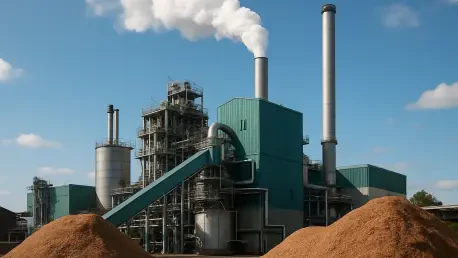California’s energy landscape is facing a pivotal moment as the state grapples with the fate of its aging biomass power plants, once a vital part of rural energy production but now reduced to just six wood-burning facilities from a high of 66 in the 1990s. These plants, contributing a mere 0.2% to the state’s electricity grid, are entangled in a web of economic dependency, environmental criticism, and the urgent need for sustainable energy solutions. Their high operational costs and perceived pollution have sparked debates over whether they remain viable or if they can be reimagined as assets in California’s ambitious clean energy transition. This exploration delves into the challenges these facilities face, their overlooked benefits in rural communities, and the potential for transformation through innovative policy and strategic planning. The question remains whether a balance can be struck between supporting forested regions and meeting long-term environmental goals, setting the stage for a critical discussion on the future of biomass energy in the Golden State.
Struggles of a Shrinking Industry
The biomass power sector in California has undergone a dramatic decline over recent decades, shrinking from a robust network of plants to a handful of struggling facilities. High operational costs, often nearing $200 per MWh compared to far lower wholesale electricity prices, have rendered these plants economically uncompetitive. Environmental concerns further compound the issue, with critics pointing to emissions and inefficiencies as reasons to phase out such energy sources. Public and policy scrutiny has intensified, questioning the value of maintaining an industry that contributes so little to the state’s power supply while carrying significant drawbacks. This situation paints a grim picture for the remaining six wood-burning plants, which must navigate a landscape where their relevance is increasingly challenged by cheaper, cleaner alternatives. The tension between maintaining operations and addressing these criticisms highlights a broader struggle within California’s energy framework to reconcile past investments with future aspirations.
Despite the mounting challenges, the historical significance of biomass plants in rural and indigenous communities cannot be overlooked. These facilities have long provided a market for wood waste, channeling resources into local economies that often lack diverse opportunities. Their presence has supported jobs and infrastructure in regions where economic stability is hard to come by, creating a lifeline for forested areas. However, this dependency also raises concerns about over-reliance on an industry facing inevitable decline. The environmental footprint of these plants, coupled with their minimal contribution to statewide energy needs, fuels arguments for a shift away from traditional biomass power. As California pushes toward cleaner energy goals, the challenge lies in addressing these economic ties without abruptly severing support for vulnerable communities. This delicate balance underscores the need for a nuanced approach to managing the industry’s downturn while preserving its localized benefits.
Hidden Value in Rural Support and Safety
Beyond their role in energy production, biomass plants serve as unexpected allies in wildfire prevention, a pressing concern in California’s fire-prone regions. Annually, these facilities process waste from 100,000 acres of forest treatments, removing flammable material that could otherwise fuel catastrophic blazes often triggered by downed utility lines. This activity not only safeguards communities but also reduces financial burdens on ratepayers who would face the costs of fire damage and recovery. The environmental benefit of mitigating wildfire risk stands in stark contrast to the criticism these plants receive for their emissions, revealing a complex duality in their impact. As the state contends with increasingly severe fire seasons, the contribution of biomass facilities to forest health management emerges as a compelling argument for rethinking their role. This protective function highlights an often-undervalued aspect of their operation, prompting a deeper look at how they fit into broader safety strategies.
For rural economies, the importance of biomass plants extends far beyond kilowatts generated, anchoring communities with limited economic alternatives. These facilities create demand for forest products, sustaining livelihoods in areas where job opportunities are scarce. Their presence fosters a cycle of economic activity, from harvesting to processing, that bolsters indigenous and rural regions dependent on forest resources. Yet, this reliance also poses a risk, as the industry’s decline threatens to disrupt these fragile economies. The challenge lies in recognizing the cultural and financial significance of these plants while preparing for a future where traditional biomass energy may no longer be viable. Policymakers must consider how to preserve the economic stability these facilities provide without locking regions into an unsustainable model. This dual role as both economic pillars and wildfire mitigators underscores the intricate web of benefits that complicates any decision to phase out or transform these plants.
Policy Band-Aids and Their Limits
Recent legislative moves, such as Assembly Bill 706 (AB 706), have sought to offer temporary relief to the beleaguered biomass industry by extending the BioMAT procurement program beyond its current expiration. This initiative prioritizes the use of wood waste for energy, aiming to stabilize the sector with financial support. However, the program has struggled to meet its 250 MW procurement target and operates at costs deemed unsustainable by many analysts. Although AB 706 cleared the California Assembly, its tabling in the Senate reflects doubts about the efficacy of such measures. Critics argue that propping up an industry with high-cost subsidies risks delaying inevitable change rather than fostering adaptation. This legislative effort, while well-intentioned, raises critical questions about whether short-term fixes can address deeper structural issues or if they merely postpone tougher decisions about the future of biomass energy in the state.
The limitations of programs like BioMAT reveal a broader concern about the direction of energy policy for biomass plants. Financial support, while providing breathing room for struggling facilities, often lacks the vision needed for long-term transformation. The exorbitant rates paid for biomass power under such programs stand in stark contrast to the declining costs of renewable alternatives like solar and wind, highlighting a competitiveness gap. Without a clear strategy tied to temporary measures, there’s a danger of creating a dependency that hinders innovation. Stakeholders must weigh the immediate benefits of legislative lifelines against the risk of stalling progress toward more sustainable energy solutions. The debate surrounding AB 706 exemplifies the challenge of balancing urgent economic needs with the imperative to transition away from outdated models. A more comprehensive approach, integrating short-term aid with concrete phaseout plans, appears essential to avoid perpetuating an unworkable system.
Charting a Path to Transformation
Advocates for change, including industry analysts, propose a proactive, region-centered strategy to shift away from traditional bioenergy reliance. Rather than developing new sites, the emphasis should be on repurposing existing industrial infrastructure for non-combustion applications within the emerging bioeconomy. This approach aligns with California’s environmental objectives by reducing emissions and preserving natural landscapes. It also draws lessons from other resource-dependent regions, such as coal communities, where a lack of transition planning led to economic hardship. A managed phaseout, supported by defined timelines and funding to access new markets, could prevent similar outcomes for forested areas. Such a strategy prioritizes the needs of local stakeholders while steering the state toward cleaner, more viable energy practices. The focus on adaptation over expansion signals a forward-thinking mindset crucial for navigating the complexities of this energy shift.
Investment in transition planning must go hand in hand with immediate support to ensure rural communities are not left stranded. Developing alternative uses for biomass infrastructure, such as producing sustainable materials or bio-based products, offers a pathway to diversify local economies. This requires not only financial backing but also collaboration between policymakers, industry leaders, and community representatives to identify feasible opportunities. The goal is to create a framework where aging plants evolve into hubs of innovation rather than relics of a bygone era. Learning from past industrial transitions, California has a chance to implement measures that cushion the impact on workers and regions tied to biomass. By integrating economic development with environmental goals, the state can address the dual challenge of supporting vulnerable populations while advancing its clean energy agenda. This balanced vision is key to transforming a struggling sector into a cornerstone of sustainable progress.
Envisioning a Sustainable Bioeconomy
California’s vast forest resources present a unique opportunity to build a robust bioeconomy that supports clean energy and enhances resilience against climate threats like wildfires. Repurposing biomass plants for innovative, non-combustion purposes could position them as assets in the state’s energy transition, turning liabilities into engines of sustainable growth. This shift involves leveraging forest byproducts for advanced materials or renewable fuels, sectors with growing global demand. Such a pivot not only aligns with environmental priorities but also promises to diversify regional economies long dependent on traditional power generation. The potential to create new markets for forest products offers a lifeline to rural areas, provided there is sufficient investment and strategic guidance. This vision of a bioeconomy represents a forward-looking solution that could redefine the role of biomass infrastructure in California’s future.
Collaboration and dialogue will be instrumental in shaping this emerging sector, with platforms like the California Economic Summit in Stockton providing a venue for actionable ideas. Bringing together policymakers, industry experts, and community leaders, such events can foster consensus on how to grow a bioeconomy that benefits all stakeholders. The focus should be on developing concrete policies, from funding mechanisms to training programs, that enable regions to transition smoothly. Attention must also be paid to ensuring equity, so that rural and indigenous communities are not sidelined in the rush toward innovation. By prioritizing sustainable industrial transformation over new development, California can set a precedent for balancing economic vitality with climate goals. The road ahead requires commitment to re-engineering existing assets into pillars of a cleaner, more resilient energy landscape. This collective effort holds the promise of turning past challenges into future opportunities for the state’s forested regions.









